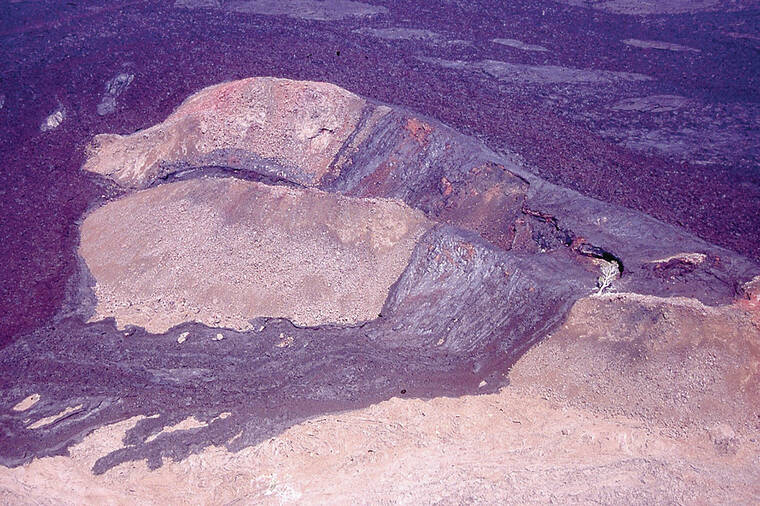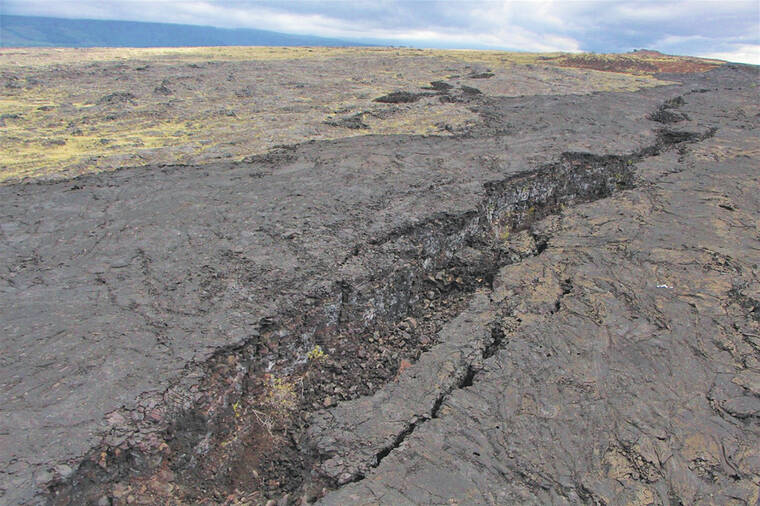Volcano Watch: The most unusual Kilauea eruption…maybe 1823?
Last month a “Volcano Watch” article discussed the bicentennial of the first visit of westerners to Kilauea caldera, led by English missionary William Ellis, in 1823. Ellis did not just visit the summit region; he had approached from Ka‘u, traveling along what eventually became known as Kilauea’s Southwest Rift Zone (SWRZ). Ellis first witnessed evidence of Kilauea’s restlessness there, in the form of a vast, 4.8-square-mile (12.5 square-kilometer) lava flow that had erupted just a short time before.
The eruption was over by the time Ellis passed through the Keaiwa area, just east of the modern town of Pahala, from July 30–31, 1823. The lava was still steaming, and in places too hot to walk on. Although lava flows can retain heat for many years after an eruption, it seems unlikely in this case, because the flows from this eruption are unusually thin: in most places, the thickness is less than 1 meter (yard).
Thinner lava flows dissipate heat much more quickly than thicker ones; therefore, we can assume that the flows visited by Ellis had been molten no more than a few weeks earlier. This assumption aligns with oral accounts from native Hawaiians in the surrounding area, who reported that the eruption had occurred less than a month prior.
Over the past century, Hawaiian Volcano Observatory (HVO) scientists have occasionally visited the Keaiwa area to study the eruptive features in detail. They have notably found pahoehoe lava veneers lapping up the flanks of older cinder cones, several yards (meters) high, resulting in the name “Lava Plastered Cones” that appear on maps of the area.
The thin lava veneers on the cones are indicative of high flow velocities, enough to overcome topography standing in the eruption’s way. Think of a water slide with a jump at the end, where fast-moving water briefly flows uphill. At such high velocities, the entire flow would have been emplaced over just a handful of days. In combination with Ellis’s reports, this evidence suggests that the eruption most likely occurred in early to mid-July 1823.
Seeing that this eruption produced relatively thin and fast-moving pahoehoe flows, we know that the lava had a low viscosity. Essentially, it spread across the preexisting ground surface like a coat of spilled paint, rather than sticky tar. But why was the viscosity so low? For most Hawaiian eruptions, such low-viscosity lava is only found very close to the eruptive vent, not over the whole flow field as in 1823.
The 1823 eruptive fissure holds clues that may help answer this question. This fissure — part of the feature famously known as the “Great Crack” — stretches 18 miles (12 kilometers) with widths up to 50 feet (15 meters). This width is especially impressive, as most Hawaiian fissures only widen to about 1 yard (meter). The 1823 fissure is also unusual in having no substantial spatter deposits along its length; it’s just a big crack where lava welled up from below and then flowed downhill.
It is likely that the Great Crack existed prior to 1823, but it was possibly cleaved more apart by the intrusion of a subsurface magmatic dike when the eruption started. Large blocks of older rock that dropped into the opening and were coated in 1823 lava offer possible evidence that the crack was widening during the eruption. Prolonged dilation may have prevented the eruption from localizing at one vent, thus influencing the character of the effused lava.
Another factor to consider is the location of the 1823 eruption, it occurred at a lower elevation along the SWRZ than any event since. The lower end of the fissure system was close enough to sea level that it produced small phreatic explosions, as magma interacted with shallow groundwater. One plausible explanation is that the low elevation eruption engaged an unusually strong pressure gradient in the volcanic plumbing system from Kilauea’s summit, driving magma to the lower SWRZ with greater force and speed.
HVO scientists continue working to solve the mysteries of the 1823 Kilauea Southwest Rift Zone eruption, but after 200 years, some questions will inevitably remain unanswered. That is, until another similar eruption occurs that we can observe for ourselves — unlikely in our lifetimes, but generally if something has happened once on a volcano, it can happen again!
Volcano Activity Updates
Kilauea is not erupting. Its USGS Volcano Alert level is ADVISORY.
Active lava has not been visible within Halema‘uma‘u crater at the summit of Kilauea since June 19. Earthquake activity in the summit region remained elevated over the past week. Summit tiltmeters generally showed inflation over the past week. A sulfur dioxide (SO2) emission rate of approximately 86 tonnes per day was measured on August 10.
Mauna Loa is not erupting. Its USGS Volcano Alert Level is at NORMAL.
Webcams show no signs of activity on Mauna Loa. Seismicity remains low. Summit ground deformation rates indicate slow inflation as magma replenishes the reservoir system following the recent eruption. SO2 emission rates are at background levels.
There were four earthquakes with three or more felt reports in the Hawaiian Islands during the past week: a M3.0 earthquake 7 km (4 mi) SW of Volcano at 1 km (1 mi) depth on August 15 at 11:37 a.m. HST, a M4.3 earthquake 6 km (3 mi) WNW of Volcano at 25 km (15 mi) depth on August 13 at 1:36 p.m. HST, a M3.2 earthquake 12 km (7 mi) S of Fern Forest at 5 km (3 mi) depth on August 11 at 9:23 p.m. HST, and a M3.4 earthquake 48 km (29 mi) ESE of Naalehu at 42 km (26 mi) depth on August 11 at 10:15 a.m. HST.
HVO continues to closely monitor Kilauea and Mauna Loa.
Please visit HVO’s website for past Volcano Watch articles, Kilauea and Mauna Loa updates, volcano photos, maps, recent earthquake information, and more. Email questions to askHVO@usgs.gov.
Volcano Watch is a weekly article and activity update written by U.S. Geological Survey Hawaiian Volcano Observatory scientists and affiliates.



